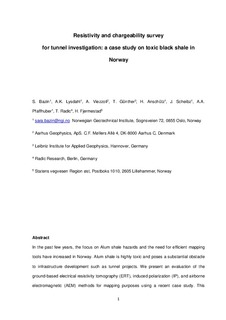Resistivity and chargeability survey for tunnel investigation: a case study on toxic black shale in Norway
Bazin, Sara; Lysdahl, Asgeir Olaf Kydland; Viezzoli, Andrea; Gunther, T; Anschütz, Helgard; Scheibz, Jürgen; Pfaffhuber, Andreas Aspmo; Radic, T; Fjermestad, Halldis
Journal article, Peer reviewed
Accepted version
Permanent lenke
http://hdl.handle.net/11250/2499351Utgivelsesdato
2017Metadata
Vis full innførselSamlinger
- NGI articles [1037]
Sammendrag
In the past few years, the focus on Alum shale hazards and the need for efficient mapping tools have increased in Norway. Alum shale is highly toxic and poses a substantial obstacle to infrastructure development such as tunnel projects. We present an evaluation of the ground-based electrical resistivity tomography, induced polarisation, and airborne electromagnetic methods for mapping purposes using a recent case study. This evaluation is done in combination with resistivity and chargeability laboratory measurements applied on drill cores. The aim of the geophysical survey was to improve the knowledge of Alum shale occurrence to assist a tunnel project in Gran, southeast Norway. Resistivity and chargeability models derived from an electrical resistivity tomography/induced polarisation survey enabled us to map the presence of Alum shale during the tunnel investigation. The resistivity models point to geological layers that are in agreement with the rock types observed from early drillings together with subsequent geological logging during tunnelling. The time-domain chargeability models are imperfect but nonetheless reveal the presence of polarisable minerals. These are likely due to the high levels of sulphides contained in black shale. An airborne electromagnetic survey was done close to the area of interest, which enabled us to fly some sparse lines across the tunnel alignment as a piggyback survey. Although the airborne electromagnetic resolution is lower than electrical resistivity tomography, the successful test flight lines illustrate the potential of airborne electromagnetic surveys for Alum shale mapping in Norway and affirm the promise of airborne electromagnetic in the early stages of project exploration.
